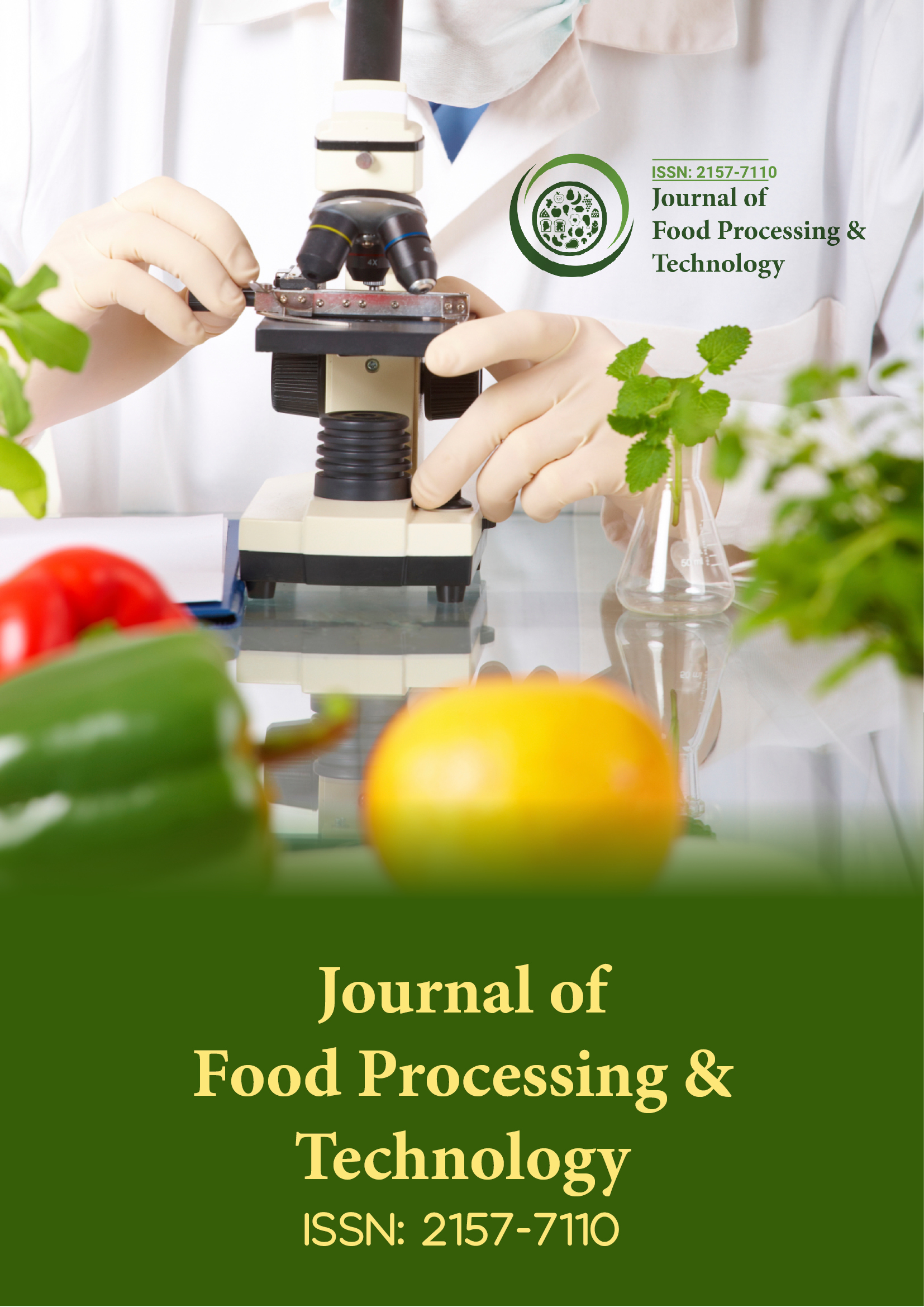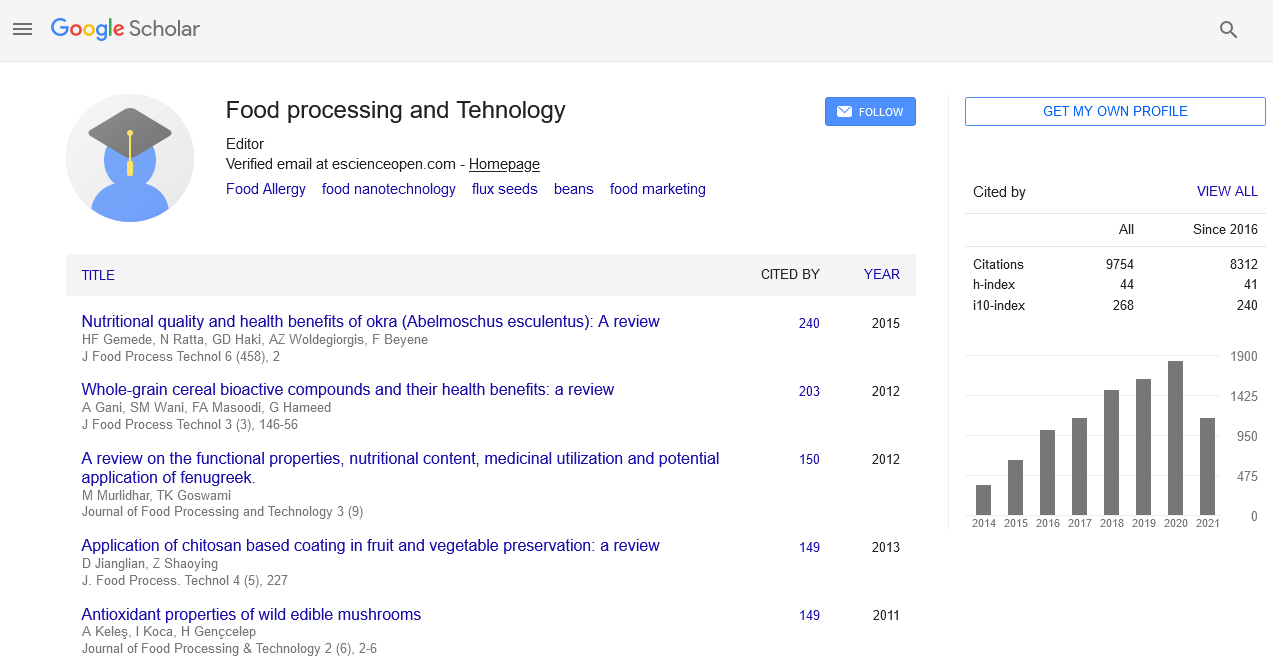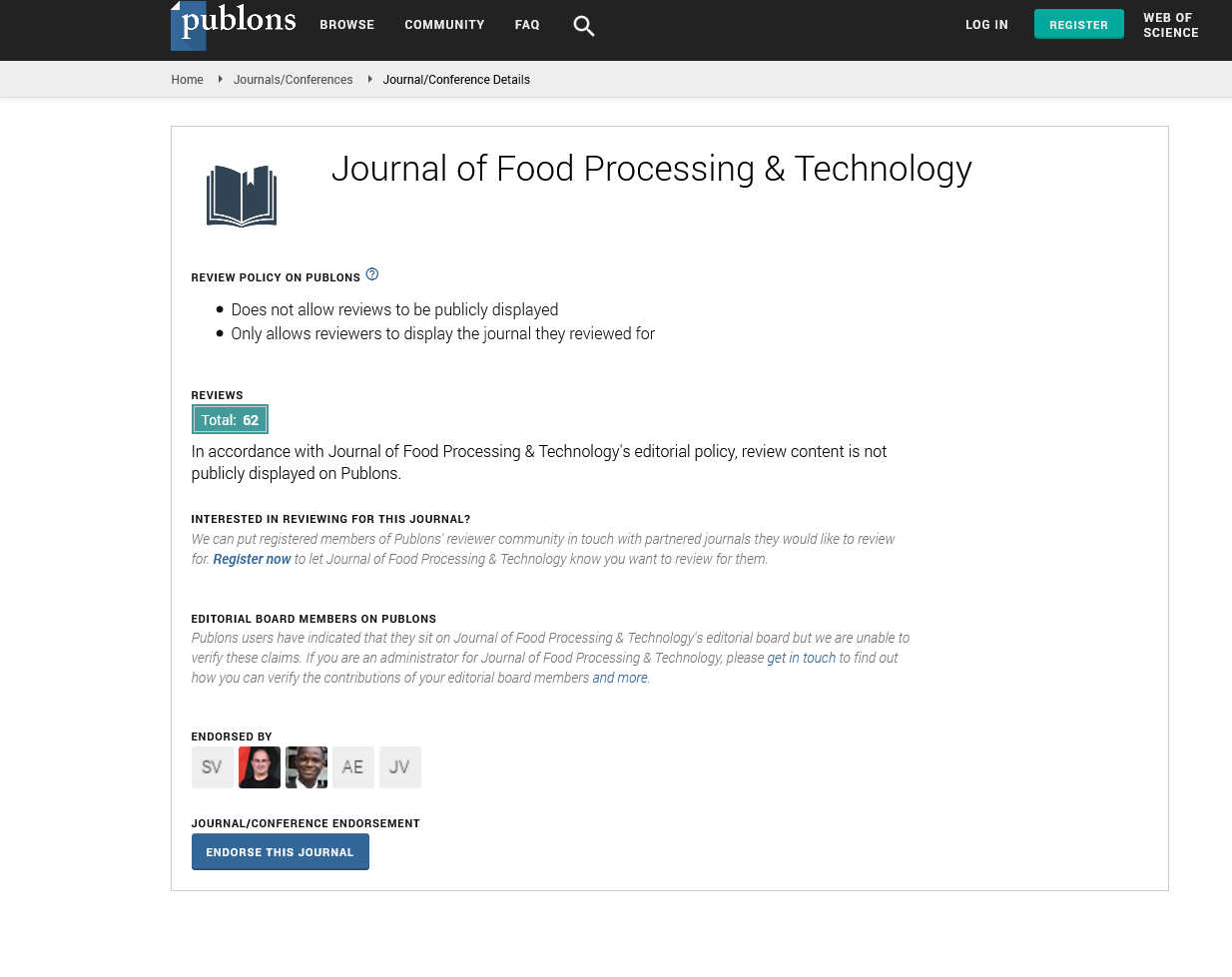Indexed In
- Genamics JournalSeek
- Academic Keys
- JournalTOCs
- China National Knowledge Infrastructure (CNKI)
- Access to Global Online Research in Agriculture (AGORA)
- Centre for Agriculture and Biosciences International (CABI)
- RefSeek
- Directory of Research Journal Indexing (DRJI)
- Hamdard University
- EBSCO A-Z
- OCLC- WorldCat
- Scholarsteer
- SWB online catalog
- Publons
- Euro Pub
- Google Scholar
Useful Links
Share This Page
Journal Flyer

Open Access Journals
- Agri and Aquaculture
- Biochemistry
- Bioinformatics & Systems Biology
- Business & Management
- Chemistry
- Clinical Sciences
- Engineering
- Food & Nutrition
- General Science
- Genetics & Molecular Biology
- Immunology & Microbiology
- Medical Sciences
- Neuroscience & Psychology
- Nursing & Health Care
- Pharmaceutical Sciences
Commentary - (2025) Volume 16, Issue 3
Application of Fermented Soy Products in Functional Food Development
Yuki Matsumoto*Received: 26-May-2025, Manuscript No. JFPT-25-29644; Editor assigned: 28-May-2025, Pre QC No. JFPT-25-29644; Reviewed: 11-Jun-2025, QC No. JFPT-25-29644; Revised: 19-Jun-2025, Manuscript No. JFPT-25-29644; Published: 25-Jun-2025, DOI: 10.35248/2157-7110.25.16.1167
Description
Fermented soy products, including miso, tempeh and natto, have been integral to traditional diets in many Asian countries for centuries. Beyond their culinary appeal, these products are increasingly recognized worldwide for their nutritional and functional properties. Rich in high-quality proteins, essential amino acids, isoflavones and bioactive peptides, fermented soy foods offer numerous health benefits. The presence of beneficial microorganisms, including lactic acid bacteria and other probiotics, further enhances their appeal as functional foods. In recent years, the global trend toward plant-based diets, wellness foods and gut health awareness has positioned fermented soy products as a key area of innovation in food science and processing. The fermentation process itself plays a pivotal role in enhancing the nutritional quality and bioavailability of soy components. During fermentation, complex soy proteins are broken down into smaller peptides and free amino acids, which improves digestibility and facilitates more efficient absorption in the human body. This enzymatic breakdown also generates bioactive peptides that exhibit antioxidant, antihypertensive and anti-inflammatory properties. For instance, natto contains nattokinase, a fibrinolytic enzyme studied for its potential cardiovascular benefits, including the prevention of blood clot formation. Fermented soy isoflavones are similarly more bioavailable than those in unfermented soy, meaning that they can exert stronger physiological effects, such as supporting bone health and modulating estrogen-related pathways in postmenopausal women.
Another key advantage of fermented soy products is the enrichment of probiotics and other beneficial microorganisms. Lactic acid bacteria, Bacillus subtilis (found in natto) and other microbial strains naturally present in fermented soy contribute to gut health by maintaining a balanced microbiota. These microbes enhance nutrient absorption, support immune function and may produce metabolites that positively influence metabolic health. This probiotic component has made fermented soy a focus in the development of functional foods aimed at promoting digestive wellness. By incorporating fermented soy into modern dietary formulations, food technologists can deliver products that combine traditional nutritional benefits with contemporary health claims. The versatility of fermented soy also opens the door to innovative applications in beverages, snacks and nutraceuticals. For example, soy-based probiotic drinks are gaining popularity as a convenient way to deliver both plant-based proteins and beneficial microorganisms. Miso and tempeh extracts are being incorporated into soups, sauces and ready-to-eat meals, offering consumers familiar flavors along with enhanced nutritional value. Snack products fortified with fermented soy peptides and isoflavones are emerging in the market, targeting health-conscious consumers seeking functional foods that support heart health, gut function, or overall wellness. These adaptations bridge the gap between traditional dietary practices and modern lifestyles, expanding the availability of fermented soy products beyond ethnic markets.
From a technological perspective, optimizing fermentation techniques is critical for maximizing the health benefits of soy-based functional foods. Selection of specific microbial strains, control of fermentation time and temperature and maintenance of hygienic processing conditions are essential to ensure consistent product quality and bioactive compound stability. Novel approaches such as co-fermentation with probiotic strains or enzyme-assisted fermentation are being explored to further enhance the nutritional profile and functional properties of soy products. For instance, co-fermentation can increase the concentration of bioactive peptides while also improving flavor and texture, making the final product more appealing to consumers unfamiliar with traditional soy foods. Fermented soy products are also important in the context of sustainable and plant-based nutrition. As consumers seek alternatives to animal-derived proteins, soy offers a complete protein source with low environmental impact. By integrating fermentation, the functional value of soy is amplified, providing products that not only meet protein requirements but also deliver additional health benefits. The combination of plant-based nutrition, bioactive compounds and probiotics positions fermented soy as a valuable ingredient in the growing global market for functional and wellness-oriented foods.
Ongoing research continues to explore the full potential of fermented soy in enhancing human health. Studies are investigating the stability of bioactive compounds during processing and storage, the interaction of microbial metabolites with the gut microbiome and the development of new product formats to improve consumer acceptance. With increasing awareness of the link between diet and chronic disease prevention, fermented soy is well-suited to address both nutritional needs and functional health demands in diverse populations. In conclusion, fermented soy products such as miso, tempeh and natto represent a rich source of high-quality protein, bioactive compounds and probiotics, offering a wide array of nutritional and health benefits. Their integration into modern functional foods, beverages and nutraceuticals demonstrates the potential to combine traditional dietary practices with contemporary consumer preferences. Continued innovation in fermentation techniques, strain selection and product development will expand the reach of soy-based functional foods in global markets, delivering both wellness benefits and sustainable, plant-based nutrition to an increasingly health-conscious population.
Citation: Matsumoto Y (2025). Application of Fermented Soy Products in Functional Food Development. J Food Process Technol.16: 1167.
Copyright: © 2025 Matsumoto Y. This is an open access article distributed under the terms of the Creative Commons Attribution License, which permits unrestricted use, distribution and reproduction in any medium, provided the original author and source are credited.


